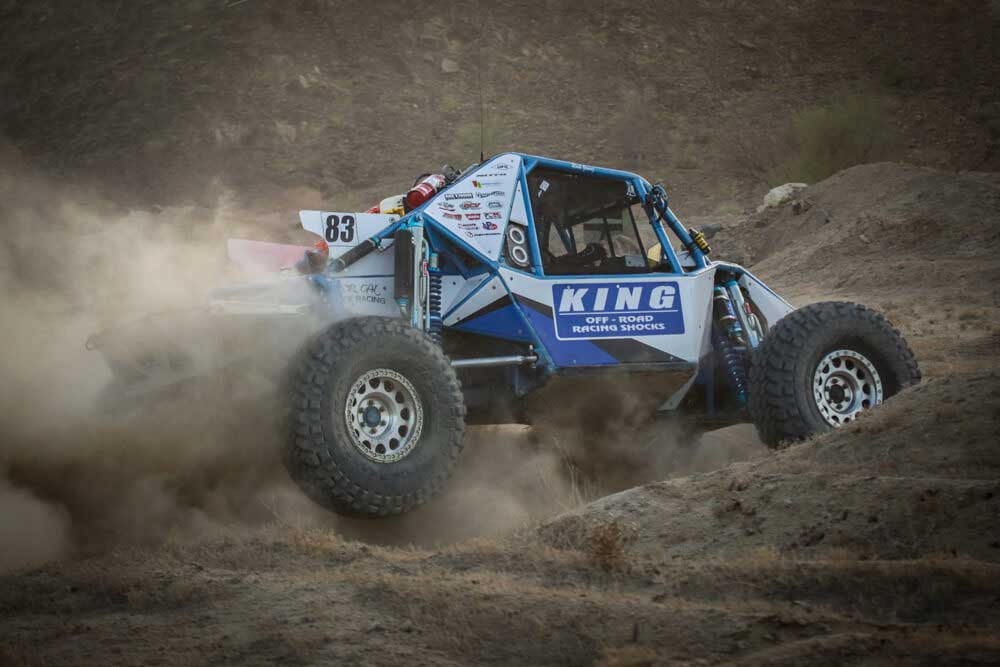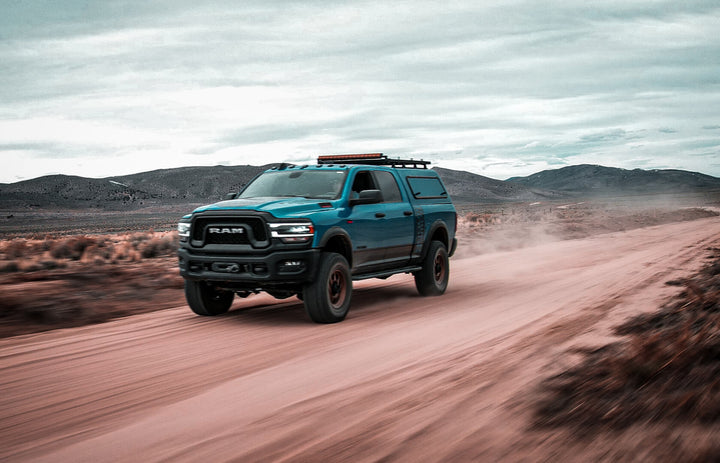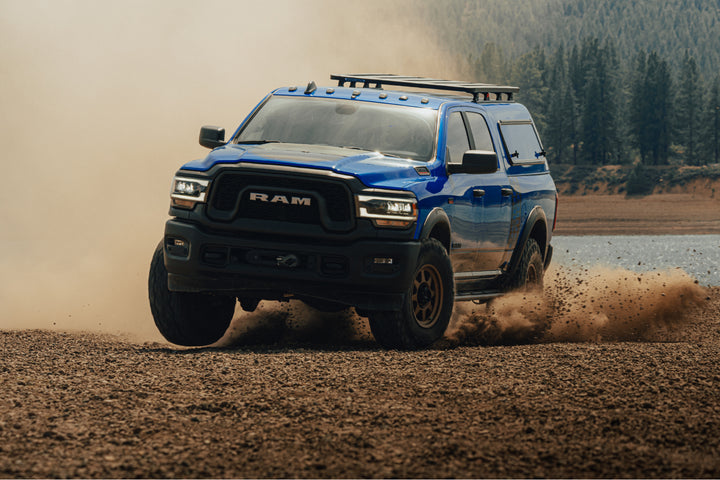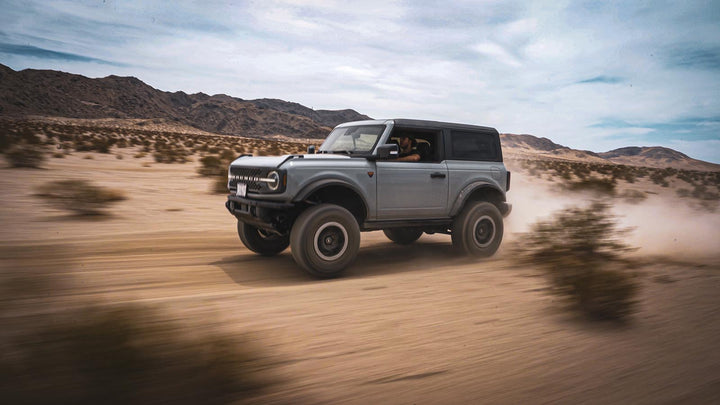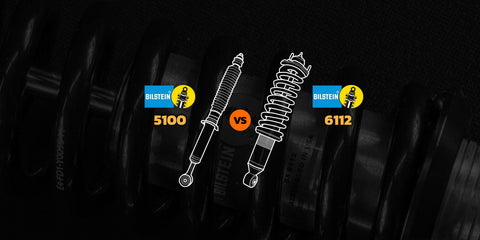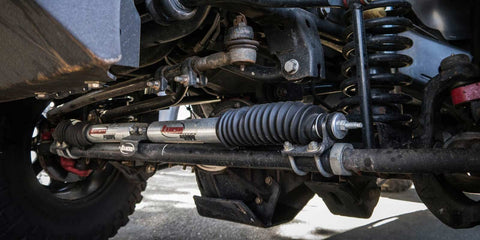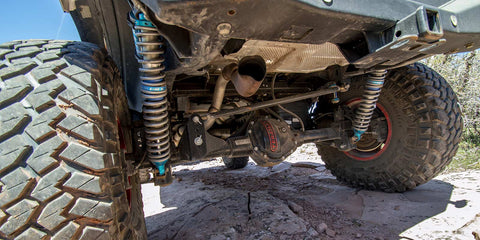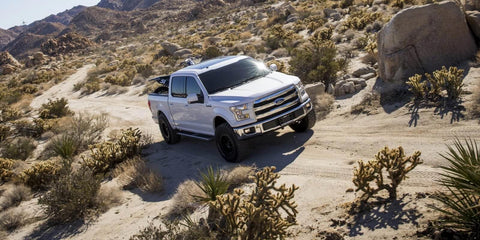Fox vs King vs Icon Shocks
Posted by Sean Law-Bowman on
Introduction
In This Article
Contrary to popular belief, each of these brands aims to achieve very similar performance with their respective comparable lines of shocks and coilovers. The differences lie in how they approach this goal and the compromises they make to attain that performance, distinguishing each of these companies and their dampers from one another.
Company Profiles

FOX Shocks
Without a doubt, Fox Racing Shocks is not only a behemoth in the present company of companies, they are objectively one of the largest names in performance suspension in just about every industry with wheels (and some without). To put in perspective, Fox will do about $1.5b in sales for 2023 across trucks, SUVs, Jeeps, off-road, bikes, snow mobile. They know how to make shocks efficiently and to performance standards.
As a premium supplier to a multitude of OEs like Ford, Jeep, and Toyota on their highest off-road trims, Fox builds parts with the large margin of safety and fit and finish on par with or above what you would see from the factory.
Being a massive global company also means they execute with the most advanced manufacturing techniques, which allows them to produce dampers that other brands cant match, such as aluminum 2" shock bodies at scale.
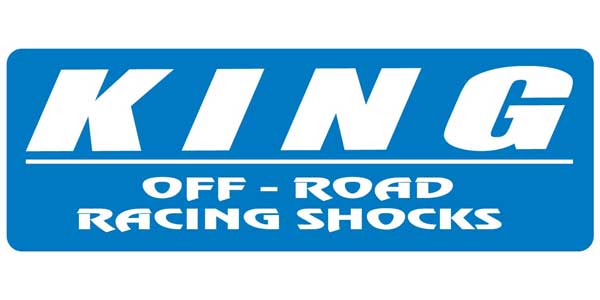
King Shocks
Although King, in comparison, is a mere dot on the map compared to a titan like Fox, that hasn't stopped them from being equally dominant on the race course. Their primary focus is on dampers for race rigs or builds that may require more than your typical bolt-on shocks, which is truly reflected in their capability and willingness to deviate from the norm and create something tailored to more unique requirements. From custom lengths for your given ride height, or specific shock tuning to keep up with your driving habits, King Shocks are just that little bit more flexible than everybody else. If blue isn’t your color, there’s a range of other color-customization available directly from King. Their smaller size, propensity for customization, and prioritization on racing do frequently make inventory scarce and lead times often a little longer on their OE Performance series of parts. On the other hand it also opens them up to better customer support with things like monthly valving events, customized tuning help, and clear communication on build times and ETAs.Icon Vehicle Dynamics
Even though Icon may not be as prolific on the various race circuits out there, it has, in many ways, led to their benefit rather than their detriment. This has enabled them to approach bolt-on performance suspension solutions from a completely different perspective. Instead of simply trickling down knowledge, components, and tuning from race cars, Icon focuses on building more comprehensive and harmonious suspension solutions with the consumer vehicle as the foundation. This includes control arms, springs, and other components that not only complement their dampers but also allow them to push the boundaries of what is achievable without requiring extensive modifications to your Tacoma or F-150 to transform it into a race-ready rig.
Whereas Fox and King are just making dampers and simply trying to maximize performance from that avenue alone, Icon manufactures the entire package which allows them to squeeze every bit of performance out of a consumer driven vehicle.
Overall, by working from the bottom up rather than the top down like the other two, Icon ends up doing things just a little bit differently but achieving a very similar result.
How’s the Quality on Each of These Shock Brands?
Whether it's due to the high volume at Fox leading to occasional glitches in their machines or the involvement of human factors at King and Icon; not every shock will be a winner. However, what sets the leading brands apart is the rarity of subpar shocks and their commitment to handling defective products and warranty claims directly, rather than passing off the responsibility to their dealers. Whether they choose to replace or repair your parts, they will support you as long as you remain patient.
Each of these shocks can be serviced and rebuilt, so when your warranty is up, and your shocks have had it, we can service and restore your shocks to how they were when new.
With anonymous feedback on the internet, whether through forums or facebook groups, many people have their perspective and story behind how the shocks failed, or how they perform. What’s usually missing is terrain, speed, tire size, tire psi, lift amount, temperature, heat cycles, and other things that contribute to ride comfort, driving experience, and product expectations.
Race-level products are durable and built for performance. That’s not the same thing as being built for the life of your vehicle on the pavement - if that’s what you’re after, go with Bilstein. These race-level performance shocks are good for a certain amount of heat-cycles, and certain operating temperatures. For instance, Fox’s JM92 oil is thick, meant for the highest operating pressures that will be seen in races, temps that will thin out the oil and settle into the preferred friction these teams are after.
Enough with the fluff, let's talk tuning.
With any basic bolt-on suspension system, there will always be compromises in valving that need to be made due to the physical limitations of a more stock-style suspension system.
Whether it be limits in potential suspension travel or clearance for the shock package, most "bolt-on" dampers have to ride a tight line between maximizing control when it counts and sacrificing too much comfort everywhere else. How these 3 companies achieve their level of performance, handling, and comfort are unique. When talking about off-the-shelf product (no custom tuning), all 3 brands are aiming for control and traction in off-road terrains at above-average speeds.

The Basics
Before diving headfirst into the idiosyncrasies of each brand, let’s do a little demystifying on some of the terms, technologies, and tendencies we will be going over with each so we do not immediately glaze the eyes of half of our readers.
From a most basic standpoint, each brand's smooth body monotube shocks all work on the same principle. Inside the oil-filled body of the shock, there is a piston at the very end of the shaft. As the shock compresses or extends, and the piston moves through the body, oil flows through that piston. The volume and rate of that flow of oil determine the shocks dampening characteristics. Although it is a bit more complicated than this, at the fundamental level, more flow equals softer, and less flow equals stiffer.
Between the brands, they have three completely different piston designs in two different styles.Fox and King use linear pistons, while Icon uses digressive pistons in most of their OE applications. From there, each brand further optimizes and specializes its tunes by using deflective shims that can further control damping through the company's target ranges.
Lineaer vs Digressive
Understanding Compression Damping and How it is Measured
Just like many other concepts, in order for those terms to be meaningful, we need to delve into some fundamental concepts, particularly relating to compression damping curves. Compression damping refers to how the shock absorber responds to and mitigates the movements of your suspension when it compresses. Rebound also plays a significant role in tuning, but for the purpose of this explanation, we will primarily focus on the compression aspect. To evaluate this, shocks are subjected to a dynamometer test where they are compressed and extended at various rates, and the force exerted to decelerate the dyno from the given input velocity is measured. Essentially, the shock is cyclically tested at incrementally increasing rates, and its response in terms of damping force or stiffness is recorded across that range. This data is then plotted on a graph with the dyno input velocity or shock shaft speed on the X-axis and shock damping force or stiffness on the Y-axis.
Put simply, the higher the dampening force a shock provides at a given shaft speed, i.e., the stiffer it acts under an event of that rate, the higher the data point will be relative to the Y-axis. Sometimes these graphs are defined by input force and displacement on the shock, but for the sake of some semblance of brevity, we will be focused on understanding shaft speed vs dampening graphs.
Low-Speed Compression
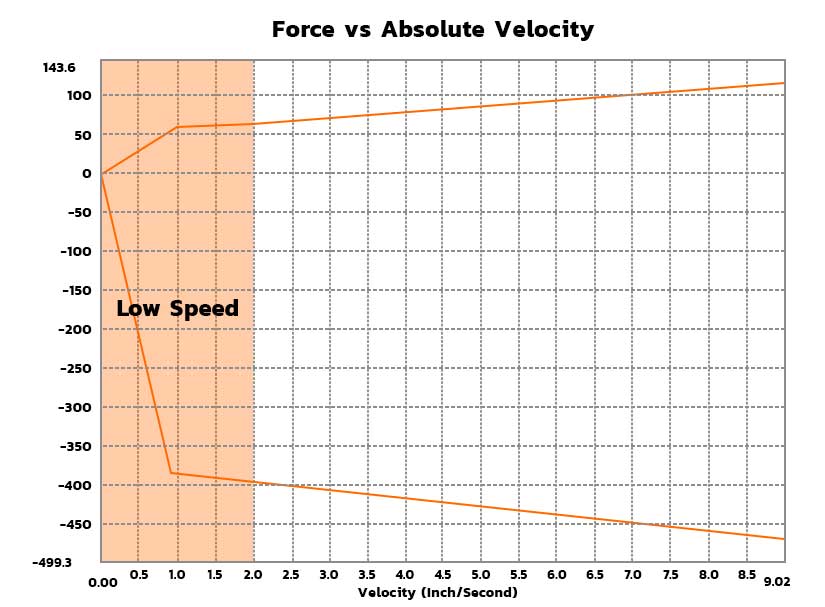
For example, you might be able to tolerate a higher level of low-speed compression damping on the road due to the surface providing ample grip. However, when off-roading, you may prefer a looser setting to allow for increased traction at higher speeds and reduce the likelihood of slipping and sliding. Although not directly tied to vehicle speed, the low-speed compression (LSC) tuning of your damper also influences stiffness when encountering slow-rolling bumps and contributes to the independent movement or articulation of individual wheels at low vehicle speeds.
High-Speed Compression

Ideally, HSC (High-Speed Compression) tuning should have minimal to no impact on ride comfort or bump stiffness in the majority of situations and during the daily commute. HSC events are things like hitting large bumps off-road quickly and with enough force to move the shock shaft through its available travel.
The focus for evaluating stiffness or firmness over bumps and determining the level of comfort or support lies on the right side of the graph, known as High-Speed Compression (HSC). The dyno graph provides insights into how shocks perform as you move further to the right or higher in shaft speed, representing larger simulated bumps or suspension events.
Linear Shocks

If the suspension encounters a low-speed event, it will respond with a softer feel, whereas it becomes firmer as the rate of suspension movement increases. For those with a fondness for introductory algebra, a dyno graph resembling a Y=X line is often employed to illustrate this concept. A shock with linear valving can be finely tuned to deliver exceptional performance over bumps. However, the inherent tendency for softer low-speed compression can result in some sway and dive.
To address this, tuning options come into play, such as the availability of low-speed compression adjusters like the ones offered by Fox on their CD and DSC adjustable shocks. These adjusters allow for an increase in low-speed compression, promoting tighter handling but also overall stiffer damping. It's worth noting that maintaining linearity is a key consideration. In essence, the shape of the damping curve remains consistent, but it may shift higher or lower on the Y-axis of the graph, akin to the adjustments of Y=X+1 or Y=X-1.
Digressive Shocks

Digressive shocks, such as the ones offered by Icon, present a slightly more intricate design. They incorporate an additional preload on the initial shims in the piston stack, specifically targeting the low-speed compression range. The purpose of this preload is to restrict flow until an event is significant enough to surpass the preload, causing deflection of the shims and enabling flow through the piston. Under ideal circumstances, these shocks should exhibit a firm response during low-speed compression events while providing a softer feel during high-speed events. This combination results in precise handling and a comfortable ride. When examining a digressive shock dyno graph, you will observe a curve that ascends almost vertically until reaching a "knuckle" or "knee" at around 50-100 mm/s, representing the low-speed compression range. Beyond this point, the curve tends to plateau as shaft speeds increase into the high-speed range.
In real-world scenarios, it is not uncommon for smaller bumps, especially at lower vehicle speeds, to lack sufficient force to overcome the preload of the initial shims. This can result in a relatively firm ride when you're not pushing the limits. However, these same characteristics make digressive shocks significantly superior to most linear shocks when it comes to handling heavier loads. Additionally, their generally softer high-speed compression attributes cause them to utilize slightly more travel than a linear shock would on larger obstacles, increasing the likelihood of bottoming out. Like Fox and King, Icon does offer some solutions to address at least some of these concerns.
How These Shock Brands Really Stack Up
Fox Shocks
- Fox shocks prioritize control and offer a tighter feel compared to other linear shocks.
- They outperform stock dampers in various aspects, making them a versatile option.
- Non-adjustable smaller body 2.0 shocks may exhibit more sway and have lower load-carrying capability compared to digressive shocks like Icon or Bilstein.
- 2.5 shocks without Dual Speed Compression (DSC) adjusters may feel firmer than other linear shocks like King.
Fox shocks prioritize control through their valving, resulting in a "tighter" feel compared to other linear shocks. While the specific feel may vary depending on body size and model line, Fox shocks excel in outperforming stock dampers across all aspects. However, their non-adjustable smaller body 2.0 shocks may exhibit slightly more sway and may not handle heavy loads as well as digressive shocks like Icon or Bilstein. Similarly, the 2.5 shocks without Dual Speed Compression (DSC) adjusters may be firmer compared to other linear shocks like King. Nonetheless, Fox strikes a favorable balance that is often missing in other brands.
For those who require a 2.0 shock but still need to carry loads, tow trailers, or prefer sharper handling, it is highly recommended to use the CD adjustable reservoir shocks, if available for your specific application. Alternatively, if you desire the best of both worlds, the DSC shocks are unparalleled. More details on why the DSC shocks are exceptional will be discussed later.
King Shocks
- King shocks offer the plushest and most linear ride among the competition, excelling in eliminating chatter at lower speeds and gliding over large obstacles at higher speeds.
- Their handling is slightly behind other brands in terms of agility, requiring a sacrifice of the plush ride to achieve tighter handling.
- Adjustments beyond the first few clicks primarily affect "Mid-Speed Compression," increasing overall compression damping or stiffness.
- King shocks require a different approach when encountering bumps at high speeds, as they are extremely soft on the left half of the damping force graph and increase significantly on the larger end.
- Driving with King shocks in rough off-road conditions resembles driving with Icon dampers, albeit for the opposite reason.
King unquestionably reigns supreme in terms of providing a plush and comfortable ride. Their off-the-shelf tunes for their OE Performance shocks and coilovers deliver the plushest and most linear characteristics among the competition.
These shocks excel in eliminating chatter at lower speeds and effortlessly glide over large obstacles at higher speeds. However, this exceptional comfort does come with a trade-off.
While the handling of King shocks is not sloppy or loose, they do lag slightly behind the other brands in terms of agility. Although their adjusters help to some extent, any adjustments made beyond the first few clicks from full soft primarily affect "Mid-Speed Compression," increasing overall compression damping or stiffness across the board. To achieve a tighter handling feel comparable to the other brands, a significant sacrifice of the plush and soft ride for which King is renowned is necessary.
While not necessarily a drawback, King shocks require a slightly different approach when encountering bumps at high speeds, which may feel unnatural to some drivers. The dampers are extremely soft on the left half of the damping force graph and significantly increase in damping force on the larger end. As a result, there are many hits that could easily be absorbed at higher speeds but may cause the vehicle to float or become unsettled at more moderate speeds. This means that drivers may need to push harder to maintain control over large impacts instead of taking a more relaxed approach and risking getting stuck in a hole. In essence, driving with King shocks in rough off-road conditions becomes quite similar to driving with Icon dampers, albeit for the opposite reason.
Icon Vehicle Dynamics
- Icon shocks offer a tighter, more connected feel with sharper handling dynamics and a sportier ride.
- They have the tightest low-speed compression characteristics and perform exceptionally well under heavy loads compared to other top brands.
- Smaller bumps or suspension events may make the shocks feel relatively stiff, but Icon's CDCV adjusters help alleviate this issue.
- Icon shocks are designed with features such as flutter stacks and a secondary bump zone to enhance performance over larger impacts.
- They provide slightly more travel than other brands, compensating for any minor differences in damping support, making them suitable for off-road driving at moderate to higher speeds.
If you prefer a tighter and more connected feel with sharper handling dynamics and a sportier ride, Icon shocks may be the right choice for you. Out of the box, they have the tightest low-speed compression characteristics and perform exceptionally well under heavy loads compared to other top brands. However, this also means that they provide the firmest ride for day-to-day use. Occasionally, smaller bumps or suspension events, especially at lower vehicle speeds, may not generate enough force to overcome the preload on the initial shims, causing the dampers to feel relatively stiff under those conditions. While Icon shocks are not completely immune to this tendency, their CDCV adjusters help alleviate it to some extent.
To enhance their performance over larger impacts, Icon has implemented several techniques. They often use flutter stacks after the preloaded shims, which offer more linear or even progressive tendencies when encountering significant obstacles, while still effectively absorbing moderate to medium-sized bumps without feeling excessively harsh. Additionally, if you choose to upgrade to their external reservoir 2.5" shocks, they utilize the reservoir bridge or port location to create a secondary bump zone that increases stiffness, preventing harsh bottom outs. By positioning the port lower on the body than typical shocks, oil flows into the reservoir until the piston passes the port. This restricts the oil flow, increasing damping force and providing additional support at the end of the suspension's stroke.
Since most of Icon's dampers are designed to work with kits that optimize usable suspension travel, they are able to achieve slightly more travel compared to other brands. In most cases, they offer similar damping support over larger impacts as their competitors, and even if there is a slight difference, they compensate with the extra travel provided by their parts. These characteristics make Icon shocks particularly suitable for off-road driving at moderate to higher speeds, similar to Kings shocks, although they soften up a bit instead of becoming more supportive like the blue guys.
Icon shocks may not be the ideal choice for someone seeking a plush and luxurious ride reminiscent of a '70s Cadillac land yacht. However, if you prefer a more sporty feel or regularly carry a substantial amount of weight in your vehicle while still desiring the ability to venture off-road, Icon shocks are an excellent option, backed by numerous vehicle tests and long-term use here at Shock Surplus.
Who’s Got the Best Click Adjusters?
All three of these brands do a spectacular job of tuning their dampers to work for a lot of people, however, a one size fits all approach does not suit everybody perfectly. Having the capacity to adjust your shocks to better suit your preferences or the driving you are doing is one of the best luxuries you can spend on when looking for a high-end suspension system. As we briefly touched on in the previous sections, these adjusters can also help dial out a little bit of the less-than-desirable characteristics each of these shocks are prone to. So which one is best?

Fox Dual Speed Compression Adjuster (DSC)
Among this group, Fox is the sole provider of an adjuster that allows for truly independent control of Low-Speed and High-Speed compression. As a standard feature, these adjusters offer 10 positions for Low-Speed Compression (LSC), which affects roll stiffness, and 12 positions for High-Speed Compression (HSC), which influences bump stiffness. Importantly, there is minimal to no interference or cross-talk between the two adjustments. In essence, you can fine-tune handling and balance characteristics using the Low-Speed knob without impacting high-speed compression events.
Since Fox predominantly utilizes linear damping profiles, the ability to enhance low-speed compression support—something that linear shocks often lack—without compromising the impressive comfort they are capable of, results in shocks that excel in almost every aspect. As standard, many of the non-adjustable 2.5 series Fox coilovers and shocks tend to have a firm ride. However, the Dynamic Suspension Control (DSC) adjuster serves as an additional means of controlling oil flow. Consequently, the base valving can be significantly softened to maximize the benefits of the DSC in parts that offer this option. This means that, from a high-speed compression standpoint, these shocks can be configured to provide enhanced comfort and support compared to their non-adjustable counterparts.
Their one fault is that they may not be able to adjust between as big of a total range as other brands' adjusters. However, the ability to make more finite adjustments in the area you are targeting without making sacrifices elsewhere does make those adjustments far more effective.
King Compression Adjusters

Kings adjuster solution is, without a doubt, far more simple in design and function than the Fox, which gives them a wide operating range; however, you will be making some compromises with your clicks. King uses a high-flow design that largely targets “Mid Speed” Compression or essentially alters the overall stiffness of the shock in both the low and high-speed portions of the damping curve.
The first couple of clicks may largely do low-speed compression only, but, there are big jumps between each click, and from there, everything else is going to be Mid Speed. This means if you find you have too much sway or dive, or it is using too much travel on long rolling low amplitude bumps, you will also have to sacrifice comfort everywhere else and vice versa. Luckily King shocks are already pretty plush, so most people can afford to sacrifice some bump compliance for better handling and body control.
Icon Compression Damping Control Valve (CDCV)
Although the Icon CDCV is more of a Mid Speed adjuster similar to the Kings, they very well may have the widest range of adjustment of the bunch. Although the adjuster does control high-speed and low-speed compression simultaneously, they can be set up softer on the high-speed side without as much loss in low-speed compression related stability since their Digressive design gives them a higher baseline to start out with. Icon usually softens valving by about 20-40% from their non-adjustable shocks, so they are much softer when the adjuster is fully open but still retain the ability to nearly double stiffness when fully closed. Their main fault lies in that they only have 10 clicks of adjustment. With such a wide range of available adjustment squeezed into just a few settings, there is a fairly vast divide between each click, which can make setup a little difficult.
Position Sensitive Designs
In the previous sections, we discussed smooth body shocks that are sensitive to the rate of movement. However, there are other shock designs that respond based on their position within the stroke. Unlike smooth body monotubes, which are unaware of the suspension's travel position, these position-sensitive shocks offer a more tailored response. The tuning of smooth body shocks necessitates compromises since they must accommodate control over both large and small suspension events. Consequently, they cannot be optimally set up for both scenarios. Performance-oriented shocks, therefore, often sacrifice some sensitivity to small bumps in order to provide increased support during larger bumps, although their capabilities in this area are still somewhat limited.
In contrast, position-sensitive shocks are equipped with multiple "ride zones," each featuring different damping profiles. Generally, these profiles gradually increase in stiffness as the shock approaches the end of its stroke. This design allows such shocks to be highly compliant during compression and more active during rebound when the vehicle is at its normal ride height or within its usual ride zone. Simultaneously, these shocks offer increased support during larger suspension events that extend beyond the normal ride zone. As a result, position-sensitive shocks greatly enhance both comfort and traction, improving stability by effectively keeping the tires planted at all speeds.
Among the various position-sensitive designs, the most common is the external bypass shock. These shocks incorporate external tubes with relief ports and adjustable check valves that allow oil to bypass the main piston. Typically, the main piston has stiffer valving compared to a traditional shock. As the piston moves beyond the bypass ports, oil is forced through the stiffer valving of the main piston, creating a firmer zone aimed at limiting and cushioning harsh bottom or top outs. The amount of flow bypassing the piston can be fine-tuned by adjusting the bypass valves located at the ends of each tube, further enhancing the ride customization.
All three brands—Fox, King, and Icon—offer a range of high-quality bolt-on external bypass shocks that share a very similar design. It's worth noting that Kings do not provide "Quick Adjust" knobs, so if you choose their shocks, remember to have your wrenches handy for testing and tuning. Apart from the slight extra effort required for their specific shocks, all the components will perform at a similar high level.
Where these brands truly differentiate themselves is in their internal bypass or sealed position-sensitive designs. External bypass shocks are not easily adaptable to coilover shocks and may not fit in many factory mounts. Therefore, each of these companies has developed their own unique designs to incorporate the benefits of position sensitivity in a package that is compatible with their respective vehicles. Since most of us cannot simply attach a coilover and bypass to each corner, having the ability to achieve similar advantages within a single shock system is tremendously valuable. While the internal bypass designs from these brands differ from one another, each offering its own distinct benefits, general characteristics, and limitations, they all strive to achieve a similar desired effect.
Fox Shocks
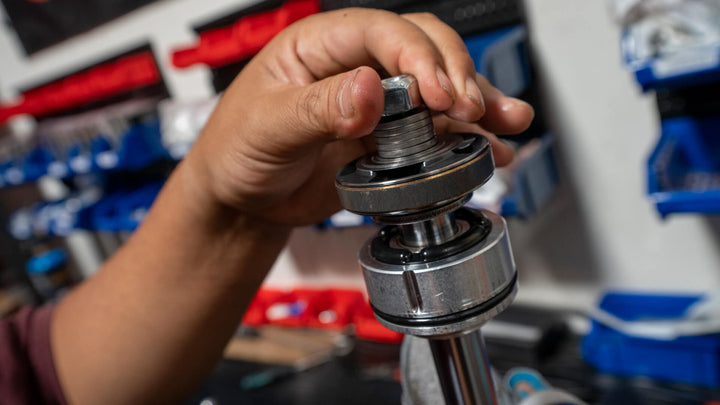
Fox's internal bypass shock design closely resembles an external bypass shock in both form and function. It operates on the same principle of bypassing the main piston through ports in the primary shock cylinder. However, instead of utilizing external tubes, the main working piston and cylinder are housed within another chamber where the bypassed oil flows. Each internal bypass port features deflective shims, similar to those found on the main piston of most shocks, which regulate flow and determine the damping characteristics within each zone. It's worth noting that the shims on the internal bypass ports can be changed after disassembling the shock body, allowing for further tuning according to specific requirements.
Compared to other position-sensitive options from different brands, Fox's internal bypass design typically offers more ride zones for both compression and rebound. However, since they lean more towards a twin-tube construction rather than a monotube design, the piston diameter is half an inch smaller than what you would find in other position-sensitive designs or a monotube shock of the same body size. For instance, Fox's 3.0 and 2.5 internal bypass shocks, despite having a 3" or 2.5" body size, have main pistons with diameters of 2.5" and 2" respectively. This means that while these shocks provide an exceptionally plush ride over moderate suspension events, they may not generate as much damping force on larger impacts compared to designs that utilize a full-size piston.
King Shocks

King IBP shocks offer a relatively simple design and easy tuning option among the position-sensitive shock designs. Their design incorporates two pistons connected to the main shock shaft: a main working piston, similar to what you would find in other shocks, and a secondary piston known as the "red piston," which functions as the internal bypass piston.
The shock body features a needle at the end that slides into the shock shaft, which is drilled with relief ports to redirect oil flow around the main piston and into the IBP. When the shock compresses, the needle enters the shaft, progressively forcing oil into the red piston and creating a second ride zone, often tuned as a "bottom-out zone." Similar to the main piston, the red piston is equipped with shims that regulate oil flow and determine the valving for compression and rebound. Tuning the red piston is much easier since it follows the same process and uses the same parts as tuning the main piston.
However, one limitation of King IBP shocks is that they can only create a second ride zone at the end of the shock's travel. As a result, they may not offer the same level of control or sensitivity throughout the entire range of travel compared to shocks like those from Fox or Icon. This is why it is common to see vehicles using a single King IBP shock focused on rebound or tuned to keep a tire up when encountering larger impacts that engage the IBP.

With only secondary control over rebound in the single upper zone, they may not be as active in handling larger obstacles as the other options. While they maintain a full-size piston unlike Fox, they are likely to recover better from individual large impacts but may struggle more with successive hits.
Overall, King IBP shocks provide a viable tuning option with their simpler design, but they may not offer the same level of terrain contact and performance as designs like those from Fox or Icon, which excel at keeping all four tires in contact with the ground, especially during demanding off-road conditions.
Icon Vehicle Dynamics
Icon's internal position-sensitive design is undoubtedly the most intricate among the options discussed. However, it also possesses the ability to generate the highest potential damping force while incorporating multiple ride zones at both ends of the shock, preventing it from "packing" like a King shock. Similar to King's IBP, Icon utilizes a main working piston with relatively soft valving and a secondary piston for the bump zone, but their approach differs significantly. The secondary or bump piston is slightly smaller in diameter and is positioned just ahead of the main piston on the shaft.
During normal ride conditions, oil flows around the bump piston and through the softer valving in the main piston, resulting in a plush and smooth ride. As the shock approaches the end of its compression stroke, the bump piston enters a smaller chamber at the shock's end, equipped with a relief or bypass port. When the bump piston enters this chamber, oil flow is restricted, but it can bypass through the port until the piston passes the middle of the chamber. At that point, oil is forced through the bump piston with minimal relief, creating even greater damping force to resist bottoming out. This configuration effectively establishes three compression zones: a soft primary ride zone where the suspension spends most of its time, a significantly firmer secondary zone to slow down the suspension and prevent hitting the bump stops, and a stiffest zone designed to soften the impact when the travel limit is reached.
On the rebound end, Icon incorporates a hydraulic stop engaged by the back side of the main piston, similar to what Bilstein uses on their 8112s and ESCV shocks. This hydraulic stop helps resist or at least soften the harsh impact when the vehicle reaches the top of its rebound stroke. As the main working piston remains active in every zone, each additional ride zone created by the bump piston assembly serves to increase the damping force, providing maximum support. The primary ride zone in these shocks is likely the largest of the three, making them less sensitive to ride height variations and offering a broader range of "soft ride" before encountering the stiffer zones. These shocks are an excellent choice for those who wish to minimize the sensation of engaging the stiffer zones. However, it's worth noting that they may utilize more travel over moderate terrain compared to other options, which can result in a slightly looser feel. A King or Fox shock might catch an event slightly earlier, allowing them to better maintain contact with the terrain and handle bumps more effectively than the Icon shock.
What Shock is Best for You?
Now we hope you understand the perspective we take at Shock Surplus when thinking about dampers, the customer, and the driving experience. If you’re in the market for a $2-5k suspension package, its important to get it right the first time.
We’ve seen plenty of regret from customers making purchases based on poor recommendations.
Each of these brands is trying to deliver very similar performance for your vehicle, and each has their own strengths and weaknesses. Comfort, durability, performance, predictability, added features, serviceability, all of these play a role in the decision.
King Shocks often have the most forgiving ride of the bunch on OE applications, being on the softer side of things regarding valving, which often times translates to more on-road comfort. But we’d be amiss if we didn’t mention King Shocks brand power in the space. There are people…communities, that will only run King Shocks and nothing else on their vehicles that see the dirt often. Reviews from them dont count, and that’s a large amount of dialogue happening out there that is biased.
With that said, our own experience on King 2.5 and 3.0 shocks has made a believer in what’s possible. Our Ram 2500 has seen a set of custom tuned 2.5 and 3.0 shocks, both with their unique behaviors, check our blog for those reviews.
Fox Racing Shocks are a little more conservative in their OE-replacement approach, that being more daily driven focused compared to high speed off-road focused. The new line of Performance Elite shocks goes to show how much their tuning approaches have changed from the 2.5 Factory Series on the same application - often tuned for more on-road comfort, and to be a bit more balanced out for the everyday driver.
Fox is also producing shocks en-masse to bring down costs for the customer - this can easily be seen in the comparison between 2.0 offerings; Fox retail $800/set, King retail $1200/set - huge difference. There’s also other value adds Fox achieves with their shocks compared to other brands that dont have the capabilities to match - aluminum shock bodies, easily accessible service kits, availability, price.
Icon Shocks seem to be the red headed stepchild in this conversation, but are delivering solid results and great feedback for customers. They’re often ahead of the curve on new applications, while both brands above take 12-24 months to deliver their first production run. Icon Vehicle Dynamics had 2022 Tundra Kits available at about the same time the truck went on sale at dealerships - Fox still hasn’t delivered anything more than a year later, and King’s first run took 6 months for shocks to arrive, limited to 2 part numbers.
Icon is delivering 4 or 5 different shocks per new application; 2.5 EXP, 2.5 Coilovers, 2.5 CDCV Coilovers, 2.5 CDEV coilovers, and in this case - 3.0 shocks for the 2022 Tundra. There’s no brand on the market (in our opinion or view) doing more R&D on factory vehicles in order to get the ride quality and off-road performance mix just right.



